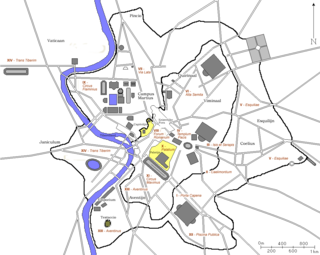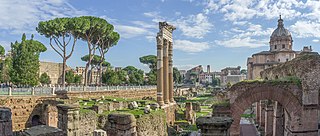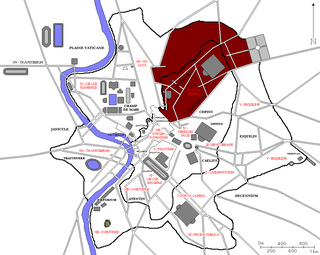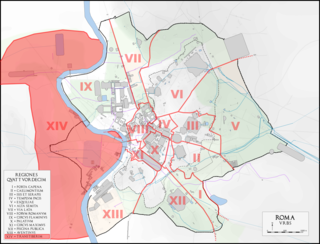
The Regio VIII Forum Romanum Magnum is the eighth regio of imperial Rome, under Augustus's administrative reform. Regio VIII took its name from the Roman Forum, the political centre of Ancient Rome.

The Regio VIII Forum Romanum Magnum is the eighth regio of imperial Rome, under Augustus's administrative reform. Regio VIII took its name from the Roman Forum, the political centre of Ancient Rome.

Regio VIII was the central region of Rome, both geographically and politically. In extent, the region was bordered by the Servian Wall to its northeast and the Palatine Hill to the southeast, while the western outcrop of the Quirinal Hill and the Via Sacra formed its eastern boundaries. It therefore included the Capitoline Hill, the valley between the Palatine and the Capitoline hills (where the Roman Forum is nestled), and the area between Velian Hill and the Palatine just before the point where the Arch of Titus straddles the Via Sacra. A measurement taken at the end of the 4th century recorded that the perimeter of the region was 13,067 Roman feet (approximately 3.86 km). [1]
The region was dominated by the massive sanctuary of Rome that sat on the crown of the Capitoline, the Temple of Jupiter Optimus Maximus. Known as the Golden Capitol, the temple's roof was covered with gilt metal tiles, the bases and capitals of its columns were gilt, as were the gates, and it was decorated with gilt statues and monuments. [2] Descending by the Clivus Capitolinus , on this stretch of road were the Temples of Concord, Saturn, and Vespasian and Titus. On the slope of the Capitoline, below the Temple of Jupiter stood the Tabularium, while close by the Temple of Concord stood the temple dedicated to the Genius Populi Romani [3] which itself stood adjacent to the most ancient of the three Rostra that were erected at various points across the Forum. [4]
This part of the Forum also contained the Arch of Tiberius (no longer in existence) and the still standing Arch of Septimius Severus. Next to, or on top of this arch, stood the bronze equestrian statue of Constantine I, which was probably removed from Rome during the visit by the Byzantine Emperor Constans II in 663. It was also near this arch that Augustus set up the Milliarium Aureum (or Golden Milestone), and the Umbilicus urbis Romae stood. Adjacent to these stood the Curia Julia (or Senate House), built by Julius Caesar and subsequently restored by Domitian.

Beside the Curia Julia along the Argiletum stood the Temple of Janus Geminus. Further along stood the Basilica Argentaria, and although beside it stood the Basilica Aemilia, the Aemilia formed part of the fourth region. Across the Forum on its southern side facing the Aemilia was the Basilica Julia, rebuilt by Diocletian after a fire destroyed the earlier structure. This part of the Forum contained the Vicus Jugarius , the Graecostasis , the Temple of Castor and Pollux and the Temple of Vesta. The southern portion of the region then terminated at the Arch of Augustus.

Moving north from the Arch of Septimius Severus, the region contained the collective Imperial Fora, a series of monumental public squares. They were four in number, the Forums of Caesar, Augustus, Nerva and Trajan. The Forum of Caesar contained the Temple of Venus Genetrix, with an equestrian statue of Julius Caesar standing in front of the temple. [5] The Forum of Augustus contained the Temple of Mars Ultor, while the Forum of Nerva contained the Temple of Minerva. The Forum of Trajan, which apart from the still standing Column of Trajan which dominated the open space, also contained an equestrian statue of Trajan, while the buildings contained an enormous library. Around the open space stood the statues of the great philosophers, poets and rhetoricians, which continued to be added to. In the fifth century, statues of Claudian and Sidonius Apollinaris were included in the Forum of Trajan. [6]
This region also included the Porticus margaritaria , as well as the sixth cohort of the Vigiles . At the turn of the 5th century, the Regio contained 34 aediculae (shrines), 130 domūs (patrician houses), 18 horrea (warehouses), 85 balneae (bath houses) and 120 loci (fountains). [7]
At the turn of the 5th century, the Regio was divided into 34 vici (districts) and 3,480 insulae (blocks). It had two curators and was served by 48 Roman magistrates. [8]

The Roman Forum, also known by its Latin name Forum Romanum, is a rectangular forum (plaza) surrounded by the ruins of several important ancient government buildings at the center of the city of Rome. Citizens of the ancient city referred to this space, originally a marketplace, as the Forum Magnum, or simply the Forum.
The Caelian Hill is one of the famous seven hills of Rome.

The Imperial Fora are a series of monumental fora, constructed in Rome over a period of one and a half centuries, between 46 BC and 113 AD. The fora were the center of the Roman Republic and of the Roman Empire.

Trajan's Forum was the last of the Imperial fora to be constructed in ancient Rome. The architect Apollodorus of Damascus oversaw its construction.

In 7 BC, Augustus divided the city of Rome into 14 administrative regions. These replaced the four regiones—or "quarters"—traditionally attributed to Servius Tullius, sixth king of Rome. They were further divided into official neighborhoods.

The Forum of Caesar, also known by the Latin Forum Iulium or Forum Julium, Forum Caesaris, was a forum built by Julius Caesar near the Forum Romanum in Rome in 46 BC.

The Regio I Porta Capena is the first regio of imperial Rome, under Augustus's administrative reform. Regio I took its name from the Porta Capena, a gate of the Servian Walls, through which the Appian Way entered the city prior to the construction of the Aurelian Walls.

The Regio II Caelimontium is the second regio of imperial Rome, under Augustus's administrative reform. It took its name from the Caelian Hill, which the region was centred on.

The Regio III Isis et Serapis was the third regio of imperial Rome, under Augustus's administrative reform. Regio III took its name from the double sanctuary of Isis and Serapis, in the area of the Via Praenestina, containing the valley that was to be the future site of the Colosseum, and parts of the Oppian and Esquiline hills.

The Regio IV Templum Pacis is the fourth regio of imperial Rome, under Augustus's administrative reform. Regio IV took its name from the Temple of Peace built in the region by the emperor Vespasian. It includes the valley between the Esquiline and the Viminal hills, the popular area of the Suburra, and the Velian Hill.

The Regio V Esquiliae is the fifth regio of imperial Rome, under Augustus's administrative reform. Regio V took its name from the Esquiline Hill. It contains parts of the Oppian Hill and Cispian Hill and of the Esquiline, plus the plain just outside the Servian Wall.

The Regio VI Alta Semita is the sixth regio of imperial Rome, under Augustus's administrative reform. Regio VI took its name from the street passing over the Quirinal Hill. It was a large regio that also encompassed the Viminal Hill, the lower slopes of the Pincian, and the valleys in-between.

The Regio VII Via Lata is the seventh regio of imperial Rome, under Augustus's administrative reform. Regio VII took its name from the wide urban street the Via Lata. It was the urban section of the Via Flaminia, which ran between the Servian walls and the Aurelian Walls, and corresponds to the modern Via del Corso. The regio contained part of the Campus Martius on the east of the street plus the Collis Hortulorum, the Pincian Hill.

The Regio IX Circus Flaminius is the ninth regio of imperial Rome, under Augustus's administrative reform. Regio IX took its name from the racecourse located in the southern end of the Campus Martius, close to Tiber Island.

The Regio X Palatium is the tenth regio of imperial Rome, under Augustus's administrative reform. Regio X took its name from the Palatine Hill and the imperial palaces located on it.

The Regio XI Circus Maximus is the eleventh regio of imperial Rome, under Augustus's administrative reform. Regio XI took its name from the Circus Maximus, located in the valley between the Palatine and the Aventine hills.

The Regio XIII Aventinus is the thirteenth regio of imperial Rome, under Augustus's administrative reform. Regio XIII took its name from the hill which dominated the region, the Aventine.

The Regio XIV Transtiberim is the fourteenth regio of imperial Rome, under Augustus's administrative reform. Meaning "across the Tiber", the Regio took its name from its position on the west bank of the Tiber River.